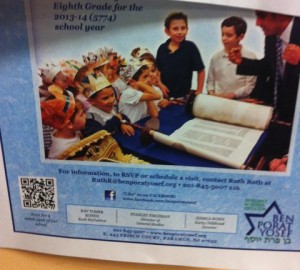
A QR code is abbreviated from Quick Response Code, and is a matrix barcode, that can be scanned on a smartphone or similar device. Nowadays, you can put a QR code on your printed brochure/flyer and people can scan it to automatically go to your website or see your video. With more and more people carrying smartphones, QR codes are being used by marketers—and even Jewish organizations—to bring printed media to life. In fact, if you want to attract seemingly instant attention to your promotional video, or want people to read about your amazing faculty, you have a greater chance of getting someone to do so on their smartphone while they are out and about, or still have that burst of inspiration. Obviously, if you expect a person to wait until they go home to type the web address into their personal computer, let alone to remember the link to the website—the chances of interacting online with that person decrease.
In Israel, the Rabbanut has decided to embrace this technology (see more on this here) so that kashrus-conscious consumers, can be that much more in the know—and ensure that the restaurant has an updated kashrus certificate.

QR codes can be used for easily giving over your contact information, increasing traffic to your website, or simply to better engage a potential student. Here are an additional twenty-two ways that nonprofits can use QR codes for fundraising and awareness campaigns. If you or your organization want to begin to incorporate QR codes into your promotional material, it will not cost you thousands of dollars. We have found a great website that will generate QR codes for free: www.qrcode.kaywa.com.
Below, we have culled some additional examples of how the Jewish world is using QR codes, so that you can refer to them for inspiration.























